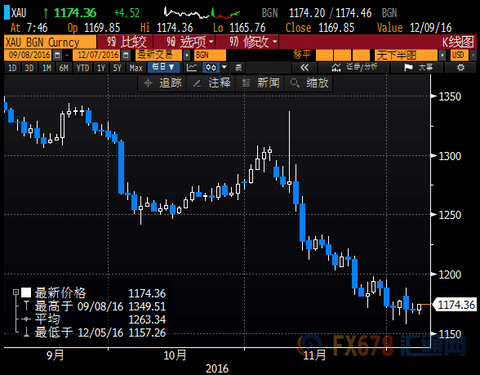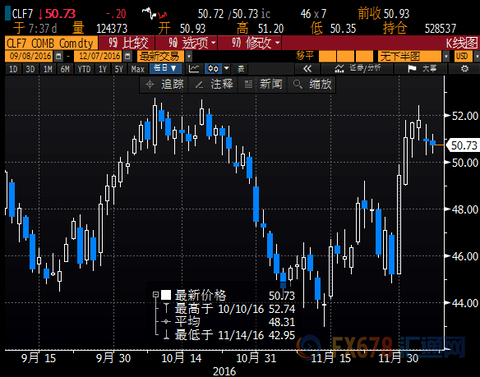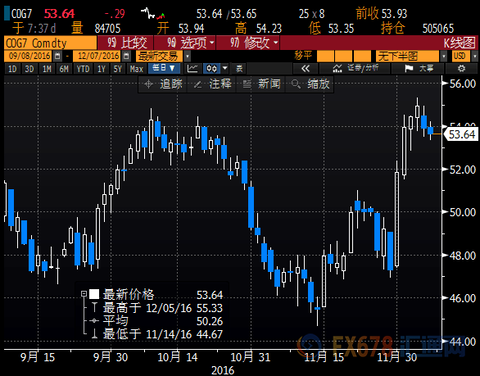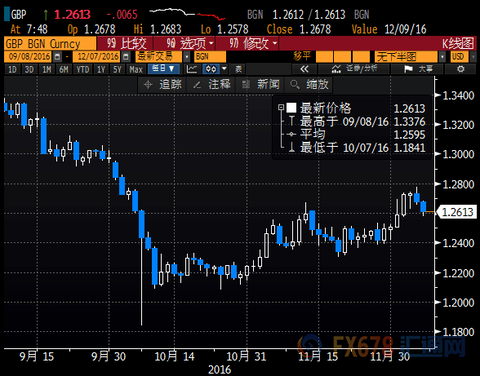Huitong.com December 7th - Wednesday (December 7th) Spot gold has a narrow range of trading, trading is relatively light, currently trading at $1171.81 before the Fed raises interest rates, the bulls are not daring to counterattack, the global stock market is relatively optimistic, gold The safe-haven buying was relatively weak; in the crude oil market, the market was concerned about the weekend meeting between OPEC countries and non-OPEC countries, oil prices were still fluctuating within a relatively high range, and the short-term market was still concerned about US inventory data. 
[Risk preference is heating up in the gold market, and gold is in a narrow range and wants to build a small bottom]
The gold market was extremely light on Wednesday. The bulls generally have concerns about the Fed’s interest rate hike action next week, and the US dollar index remains above the 100 mark, but there are still some low-end buying to provide support for the gold price, and some short-term signs of bottoming. appear. 
(Spot gold daily chart)
Ronald Leung, chief trader at Hong Kong's Lichang Gold Shop, said that everyone is waiting for the Fed's next meeting next week. At the same time, the settlement of the ETF fund and the strength of the US dollar have put pressure on the gold price.
Leung said that people will be more willing to know whether the Fed’s interest rate hike is temporary or whether there will be further interest rate hikes in the future. It is expected that with the coming of the year-end holiday, trading will tend to fluctuate.
Senior market strategist of well-known broker RJO Futures believes that the price of gold will remain below $1,200. Before the Fed meeting, gold prices are expected to continue to be sideways, even falling, and pressure will increase; in the context of rising interest rates, gold will not perform. Too good; the gold ETF's holdings fell for 17 consecutive days, the longest losing streak since March 2015; as of Monday, the holdings fell by 5.07 tons to 1854.2 tons, hitting a low since June.
However, according to FX678, the current market generally believes that gold has already digested the Fed’s interest rate hike in the current price next week. The risk of a sharp fall in gold prices has weakened. Some analysts believe that the current real interest rate is still low, and gold prices are expected. After the bottoming, I will regain the upswing.
Analysts at Commerzbank pointed out that the unfavorable factors for the appreciation of the dollar and the rise in bond yields should be reduced. In view of the many risks, investment demand should also pick up. The price of gold will rise every quarter in 2017, and the average price in the fourth quarter will reach $1,300 per ounce. At the same time, prices will continue to rise in 2018, reaching $1,400 per ounce in the third quarter.
At the same time, analysts at the bank pointed out that rising inflation should keep real interest rates that are critical to gold prices low. At present, global real interest rates are still at extremely low levels, and even partially negative real interest rates. Most Western central banks’ ultra-loose monetary policies and rising inflation rates mean that investment demand will become more active again, but it may Less than the level of the first half of 2016.
[US oil holds 50 mark, pay attention to weekend oil price]
International oil prices fluctuated at high levels on Wednesday. US crude oil January futures are currently trading at $50.71 per barrel. Brent crude February futures are currently trading at $53.67 per barrel. The market is still waiting for a weekend meeting in Vienna, although some OPEC oil captains Positive statements, and US inventory data is expected to improve, providing support for oil prices, but the market is also deeply worried about the increase in production before the official production cut. 
(US crude oil January futures daily chart) 
(Brent crude oil February futures daily chart)
Huitong.com reminded that OPEC and non-OPEC countries will hold a meeting in Vienna this weekend to finalize the details of production reduction. The overall production reduction target is about 1.5 million barrels per day.
The Nigerian oil minister said on Wednesday that it is expected to have more production cuts on Saturday (December 10) and non-OPEC meetings. Nigeria's current crude oil production is about 1.8 million barrels per day. The crude oil production target for January was 2.1 million barrels per day. I hope that the oil price will be $60/barrel by December 2017.
The UAE oil chief said on Wednesday that it is confident that the production reduction agreement will be complied with, and more countries should join the production cut. There is hope for OPEC's Vienna meeting and expects non-OPEC countries to make more production cuts. The purpose of production cuts is to balance the market, reducing production by 1.8 million barrels per day will balance the market. From the very beginning, we can see the sincerity of Russia. If the non-OPEC countries cut production this Saturday, the oil price will rise; although the shale oil may rebound, it will not increase again.
Jeffrey Halley, senior market analyst at OANDA in Singapore, said that although the OPEC agreement helped Brent oil prices rise to $55, the organization's and non-OPEC countries' production cuts will be again at the Vienna meeting on Saturday (December 10). gone through testing.
Another analyst said that although there is still doubt about the implementation of the production reduction plan, the international oil market in 2017 may be more balanced.
Nomura Securities believes that as OPEC's production cuts take effect from January, oil prices may continue to rise next year, if OPEC strictly enforces the target of 32.5 million barrels per day, and US shale oil production continues to be due to logistics problems in oilfield production recovery. If people are disappointed, the price of oil may be higher than the forecast of $60/barrel; in addition, because Saudi Arabia is willing to cut production, this will help oil prices bottom at $50/barrel next year.
BMI believes that one of the more balanced oil markets next year is that the average oil price in 2017 will be higher than 2016. The average price of Brent crude oil is expected to be US$55 in the whole year. The average level of Brent crude oil in 2016 is 44.47 per barrel. Dollar.
According to Huitong.com, the market is still worried about the increase in output before the official production cut.
After OPEC and Russia announced a joint production cut agreement last week, oil prices rose by up to 19%. However, both OPEC and Russia have announced record production, and the outside world has questioned whether the planned scale of production reduction is enough to end the oversupply of the oil market.
Analysts believe that both Russia and OPEC have set a production record, and the market doubts whether OPEC can complete the production reduction target reached at the Vienna meeting. Suspicion is justified because the higher the output of OPEC and Russia, the higher the starting point for production cuts.
In addition, Rusty Braziel, president of RBN EnergyLLC, a US energy industry website, warned that under the rule of Trump, the oil and gas industry will see many changes, which is bad news for oil prices.
From a technical point of view, the US oil market is still dominated by high-level shocks in the near future. The top continues to focus on the resistance near the $52 integer mark. The bottom is concerned with the support around $50. After effectively breaking through the range, it is expected to choose a new direction.
[Industrial output data + manufacturing data performed poorly, the pound once fell below the 1.26 mark]
Sterling fell against the US dollar on Wednesday, once fell below the 1.26 mark to 1.2579, falling from a two-month high of nearly 200 points overnight. The UK's October industrial output monthly rate and the UK's October manufacturing output monthly rate were poor. The sterling has been significantly suppressed, and the long-term profit-taking after the pound rushed to the 1.28 mark overnight is also dragged down by the formation of the pound. The daily level is concerned with the support near the 1.2492 mid-rail of the Bollinger Band. 
(Pound Sterling against the US dollar daily chart)
The data showed that the monthly industrial output rate in the UK fell by 1.3% in October, the largest decline since September 2012. It was worse than market expectations and the previous value. The market is expected to grow by 0.2%, and the previous value is down by 0.4%.
The National Bureau of Statistics said that due to the closure of the BUZZARD field, output fell sharply and industrial output was hit in October.
Reuters commented that the UK's monthly industrial output rate recorded the largest decline in more than four years in October, mainly because the closure of the Buzzard oil field led to a sharp drop in oil output, so industrial output in October was significantly lower than expected, although once the North Sea oil field routinely The end of the maintenance period will cause oil production to rebound, but the weak performance of the manufacturing industry has increased doubts about the rebound in industrial output.
The data also showed that the monthly manufacturing output rate in the UK fell by 0.9% in October, the largest decline since March 2016, and worse than expected and the previous value. The market is expected to grow by 0.2%, and the previous value is 0.6%.
FXStreet Principal Analyst Valeria Bednarik said that the downward pressure on the pound has increased significantly, and the exchange rate has fallen below the recent increase of 38.2% Fibonacci retracement level of 1.2625, which will be the initial resistance. If it can be recovered, it may ease the downward pressure and further rebound to 1.2660, but it seems unlikely at present. The 50% Fibonacci retracement level of 1.2580 will serve as an initial support, and if the code fails, it opens the door to the 1.2530 area.
Cotton Fabric,Spendex Printed Fabric,Cotton Printed Fabric,Ink Drawing Flower Fabric
Shaoxing City Jiaren Textile Co., ltd. , https://www.jiarentextile.com